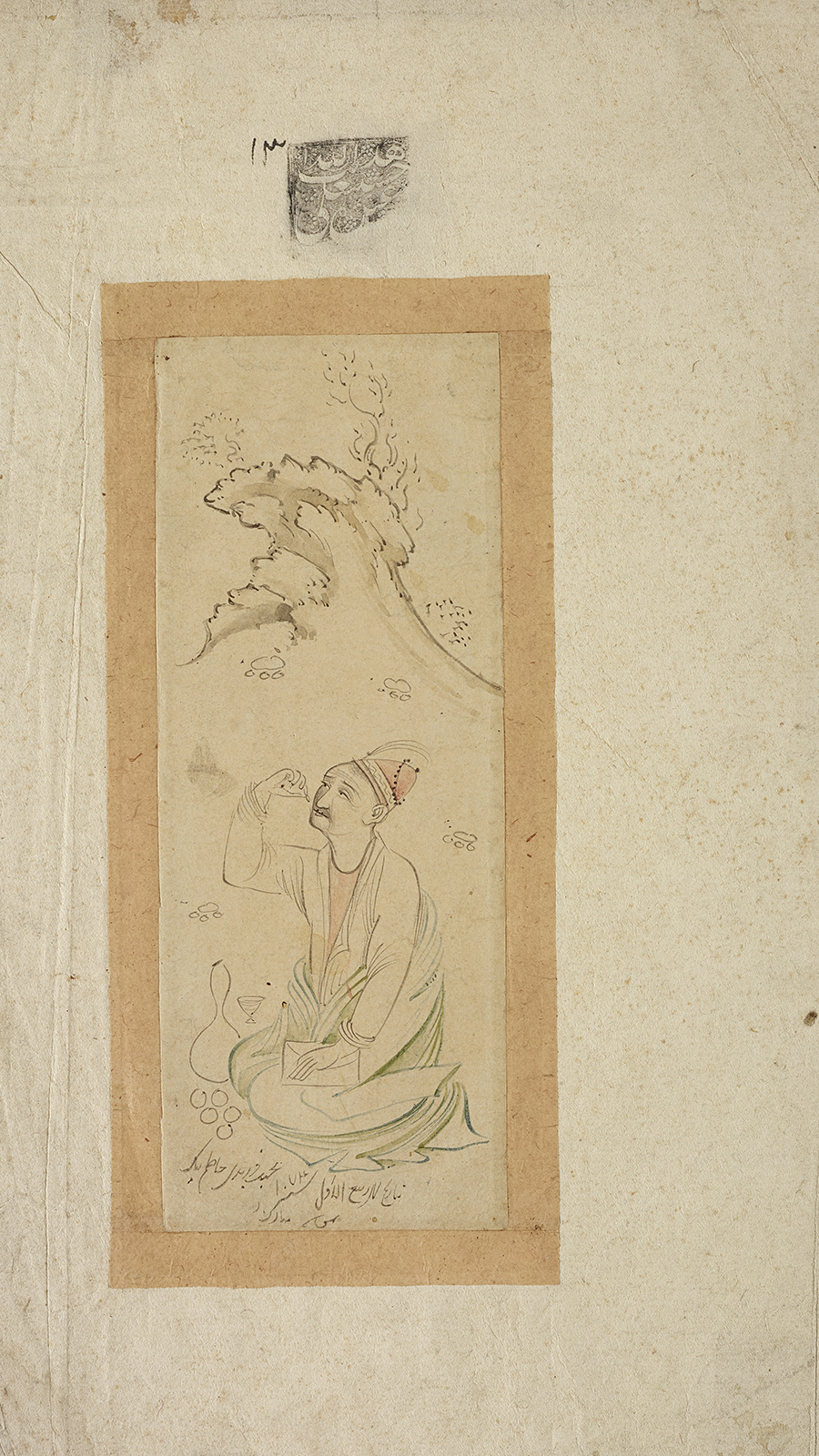Click on the image to zoom
A Dervish Kneeling in a Landscape
- Accession Number:AKM451
- Creator:Attributed to Mu’in Musavvir
- Place:Iran, Isfahan
- Dimensions:23.1 x 15.2 cm
- Date:Rabi‘ al-Awwal 1074 (October 1663)
- Materials and Technique:Ink and opaque watercolour on paper
This single-page drawing depicts a dervish (likely a follower of the mystical Sufi tradition) kneeling in a landscape. Under the influence of artists such as Reza-e ‘Abbasi, Sadeqi Beg, and Muhammadi, drawings of dervishes became popular. [1] This drawing has been attributed to Mu’in Musavvir, and the hand gesture and lines do match him stylistically; he often used different colours in his brush technique. Mu’in Musavvir, who was trained by Reza-e ‘Abbasi, had a long career and carried Reza-e ‘Abbasi’s artistic ideas and new styles into the 18th century.
Further Reading
The man can be identified as a dervish by his red felt cap and his robe, though the feather trimming and pearls on his cap do not befit the modest life of a dervish. Nonetheless, the book he holds in his lap suggests he is wise. The folio bears a seal on the top, reading: “his slave, Husseinali Hidayat Allah.” The drawing bears an inscription with an execution date, Rabi‘ al-Awwal 1074 (October 1663), and a dedication: “for my son Hatim Beg. May he be blessed!” [2] The date of the drawing also corresponds with Mu’in Musavvir’s active creative years, and it is well-known that Musavvir executed drawings dedicated to his sons. [3]
In the 17th century, many artists dedicated their works to a close person, a friend, or so-called sons. According to Massumeh Farhad, such works reflected the rise of new art connoisseurs who enjoyed and collected individual drawings. [4] The word “farzand” (used here in the dedication) can refer to both male and female offspring. Farhad further explains that it may also be used by an older person to refer to a young man for whom he nurtures some affection. [5] The tradition seems to have been developed by Reza-e ‘Abbasi, master of Mu’in Musavvir. ‘Abbasi is known to have signed and dated drawings dedicated to his son, Muhammad Shafi, a tradition that could very well have been adopted by Mu’in Musavvir and his followers.
— Filiz Çakır Phillip
Notes
[1] Sheila Canby, The Golden Age of Persian Art: 1501–1722 (London: British Museum Press, 1999), 106.
[2] Anthony Welch, Collection of Islamic Art: Prince Sadruddin Aga Khan, vol. 1 (Geneva: Château de Bellerive, 1972), 215; The Path of Princes: Masterpieces of the Aga Khan Museum Collection (Geneva: Aga Khan Trust for Culture, 2008), 26.
[3] F.H. Martin, The Miniature Painting and Painters of Persia, India, and Turkey from the 8th to the 18th Century (London: Quaritch, 1912; reprint, London: Holland Press, 1968), 125; Ivan Stchoukine, Les peintures des manuscrits de Shah ‘Abbas 1er á la fin des Safavids (Paris: Libraire Orientaliste P. Geuthner, 1964), 71; Welch, Shah Abbas and the Arts of Isfahan (New York: Asia House Society, 1973), 148; Massumeh Farhad, “The Art of Mu‘in Musavvir: A Mirror of His Times.” In Persian Masters: Five Centuries of Painting, ed. Sheila Canby (Mumbai: Marg Publications, 1990), 128.
[4] Farhad, 118.
[5] Farhad, 128.
References
Aga Khan Trust for Culture. The Path of Princes: Masterpieces of the Aga Khan Museum Collection. Geneva: Aga Khan Trust for Culture, 2008. ISBN: 9782940212022
Farhad, Massumeh. “The Art of Mu‘in Musavvir: A Mirror of His Times.” In Persian Masters: Five Centuries of Painting, ed. Sheila Canby. Mumbai: Marg Publications, 1990. 113–28. ISBN: 9788185026107
Martin, F.R. The Miniature Painting and Painters of Persia, India, and Turkey from the 8th to the 18th Century. London: Quaritch, 1912 (reprint, London: Holland Press, 1968). ISBN: 9789332896949
Phillip, Filiz Çakır. Enchanted lines: drawings from the Aga Khan Museum collection. 2014. ISBN: 9780991992874
Stchoukine, Ivan. Les peintures des manuscrits de Shah ‘Abbas 1er á la fin des Safavids. Paris: Libraire Orientaliste P. Geuthner, 1964. http://www.worldcat.org/oclc/38651958
Welch, Anthony. Collection of Islamic Art: Prince Sadruddin Aga Khan, vols. 1 and 3. Geneva: Château de Bellerive, 1972–78.
---. Shah Abbas and the Arts of Isfahan. New York: Asia House Society, 1973. ISBN: 9780878480418
Note: This online resource is reviewed and updated on an ongoing basis. We are committed to improving this information and will revise and update knowledge about this object as it becomes available.


